Introduction
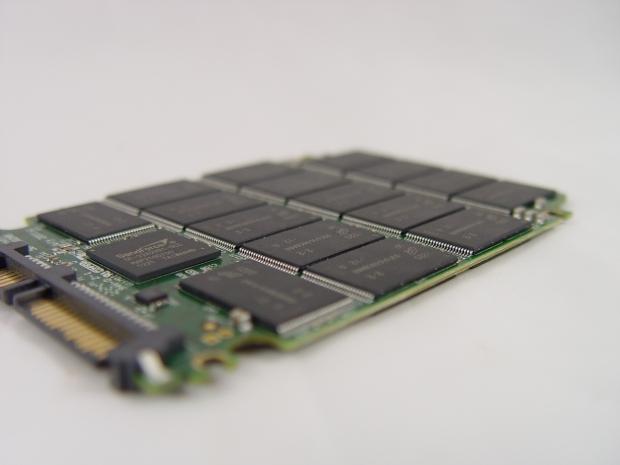
The first time I reviewed the original Force GT 240GB, Corsair was elbows deep trying to figure out the BSOD issue that plagued an untold number of users. At the time Corsair was experimenting with different SATA connectors, more compact component designs and looking into hair restoration products because their hair was being pulled out by the fist full. Well, it turned out that in many cases the SF-2281 drives didn't have a problem with connectivity, but an issue with the controller was actually responsible. The issue was eventually patched away in firmware with version 3.3.2.
Eventually Corsair could stop worrying about data eyes viewed through oscilloscopes and get back to pushing performance boundaries. Just months after our first review of the Corsair Force GT 240GB a new design was nestled underneath the famous red case. This one was something different, something special and something to get excited about.
Around the same time we reviewed the original Force GT 240GB with a 3/4 PCB design we also reviewed a special SSD from OWC. The OWC drive featured an SF-2282 controller, but the drive was still paired with 16 IMFT 25nm synchronous flash chips. The OWC drive didn't take advantage of the additional interleaving capabilities of the 2282, but after seeing the upper class SandForce controller, we knew it wouldn't be long before someone paired this controller with 32 NAND flash chips.
Well, we didn't think it would take this long, but Corsair built what we predicted would be a superior LSI SandForce SSD. The truth is though these 32 NAND flash models have been on the market for a long time. We didn't know they existed since most reviewers tested the older 16 chip, 3/4 PCB version early on in the products cycle. None of that really matters now because we have the 32 chip model in hand.
Just days ago, Corsair publicly released firmware version 5.0.3 for all of its SandForce SF-2000 Series products so we can finally put the Force GT 240GB with 32 NAND flash against the new Force GS 240GB and see which model is actually faster in this capacity size.
It's a flash face off; will more NAND and interleaving prevail or with the Force GS with higher efficiency stand at the top?
Specifications, Pricing and Availability

Corsair released a number of Force GT drives that differ by capacity size. We know of at least two different configurations for the 240GB capacity size and rumor has it the Force 3 with asynchronous flash in the 240GB capacity size also use the 32 chip design as well now. At this time Force GTs are sold in 60GB, 90GB, 120GB, 180GB, 240GB and 480GB capacity sizes.
I'd say that by this time all of the older 3/4 PCB design Force GT 240GB models are sold and everyone with stock has the new 32 chip model. On the outside you can't tell which model you have until you update the firmware. The special 240GB model with 32 chips has a code of XXXXX and you use this special designation when choosing what flash to use when updating your firmware in the Corsair update tool.
The published specifications didn't change, at least not publicly. Since SSD manufacturers only publish peak performance, there really wasn't anything to change. SSDs are three dimensional, but rarely advertised with average and minimum performance. The 32 chips design increases the minimum performance thus it also increases the average performance. With firmware 5.0.3 the performance over time is also increased since TRIM is working again, but this is universal for all SandForce SATA III SSDs and not unique to the Force GT or GS.
Firmware 5.0.3 made a bit of a stir when we managed to get our hands on it to verify that TRIM would one day return to SandForce based SSDs. Corsair was the first company to put 5.0.3 in our hands and the second company to release it, just moments after Kingston. If I were buying a new SSD today, I would want a product with working TRIM since it affects long term performance. At the time of writing only three companies have released 5.0.3 for SandForce SSDs and they are Kingston, Corsair and SuperSSpeed. OCZ Technology never fell into the 5.0.1/5.0.2 trap so you are fine with them as well.
Since the 240GB capacity size is the special one we are only going to focus on it today. Corsair gives this model a three year warranty and includes a desktop adapter bracket, screws and paper manual. Newegg has the Force GT 240GB drive listed at just $189.99, but there is also a mail in rebate worth $20 back. So, your final cost after all is said and done is $169.99.
I had to do a double take because this is a 240GB drive with 256GB of NAND flash in total. SSDs have really dropped in price over the last six months.
Packaging
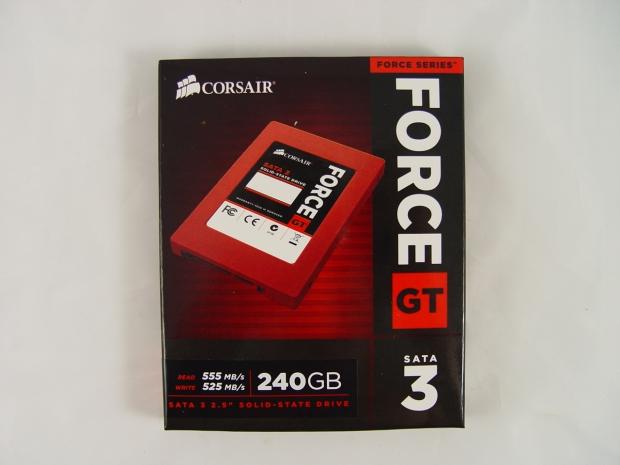
The outside package hasn't changed much since we took a look at the original Force GT.
We like that Corsair put some performance data on the front of the package. It's something we rarely see.

Some general information is on the back of the package.

The inner packaging is put together well.
The box is very thin and when you see one in person it's almost unthinkable that all of this fits inside.
Corsair Force GT 2012 240GB SSD

The new 32 chip Force GT design looks identical to the older design from the front.

The easiest way to tell if you have a 16 NAND 3/4 PCB Force GT or a new 32 NAND design is on the back. The older 16 chip design has a silver plug right in the middle on the back of the drive and you can see here, the 32 chip design doesn't.

The Force GT, just like the GS, has a standard 9.5mm z-height so these aren't going to work in many of the new ultrabooks. With 32 NAND flash chips the power draw will be quite a bit more too, but as we will show today, the Force GT 240GB is a beast for desktop use.

The SATA power and data connectors are offset to the side as they should be and the included desktop adapter bracket also offsets the drive.

A friend on Facebook the other day accused me of sleeping on NAND flash and stuffing my pillow with SandForce controllers. As you can see here, the Force GT 240GB with the new design actually makes such a feat possible.
The controller is the part that makes all of this flash possible. The LSI SandForce SF-2282 is rarely used in consumer SSDs, but luckily Corsair managed to find a good use for it.

There is flash everywhere!
Benchmarks - Test System Setup and ATTO Baseline Performance
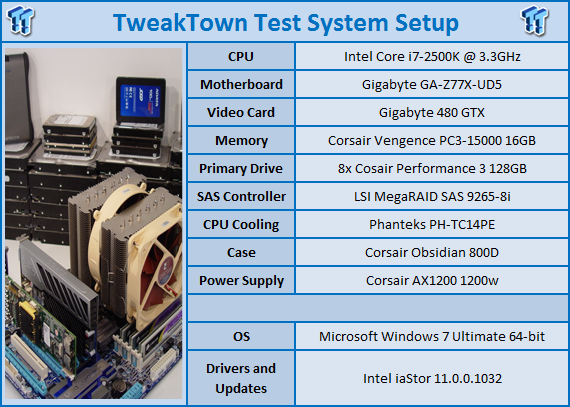
We would like to thank the following companies for supplying and supporting us with our test system hardware and equipment: AVADirect, GIGABYTE, LSI, Corsair and Noctua.
You can read more about TweakTown's Storage Product Testing Workstation and the procedures followed to test products in this article.
In order to fully utilize SATA III you need a system with native SATA III support. P67, Z68, Z77 and X79 systems are preferred, but AMD has made advances in their newer SATA III systems as well. Older X58 systems with Marvell based SATA III ports do not deliver the same high levels of performance, so we recommend newer systems when available.
ATTO Baseline Performance
Version and / or Patch Used: 2.34
ATTO is used by many disk manufacturers to determine the read and write speeds that will be presented to customers.

As we stated before the peak performance isn't going to change too much with the new flash layout, but the minimum and average performance should when the drive is under intense load.
Using ATTO, we can say that the Force GT is the fastest 240GB drive we've tested or retested (outside of a special SLC model) with firmware 5.0.3.
Benchmarks - HD Tune Pro
HD Tune Pro
Version and / or Patch Used: 4.00
Developer Homepage: http://www.efdsoftware.com
Product Homepage: http://www.hdtune.com
HD Tune is a Hard Disk utility which has the following functions:
Benchmark: measures the performance
Info: shows detailed information
Health: checks the health status by using SMART
Error Scan: scans the surface for errors
Temperature display
HD Tune Pro gives us accurate read, write and access time results and for the last couple of years has been gaining popularity amongst reviewers. It is now considered a must have application for storage device testing.
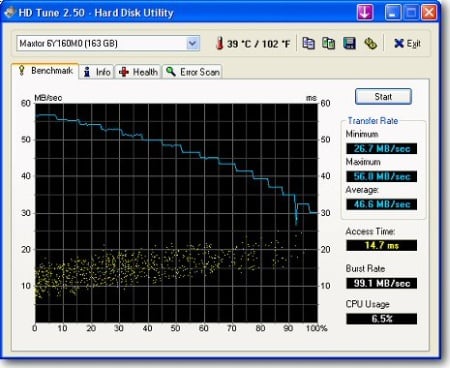

The keyword in all of this is intense loads. We'll add to that a little later in this review. To be honest, the performance difference under typical benchmarks is like splitting hairs. There isn't a difference until we really get the drives under load, at least for the difference between the Force and Force GS.

Incompressible data performance is also a bit higher with the Force GT 32 chip design, but we'll have to wait for those tests which appear a little later on in this review.
In HD Tune Pro, we see the read and write performance you would expect from a well put together SandForce based SSD.
Benchmarks - AIDA64 Random Access Time
AIDA64 Random Access Time
Version and / or Patch Used: 1.60
Developer Homepage: http://www.aida64.com
Product Homepage: http://www.aida64.com
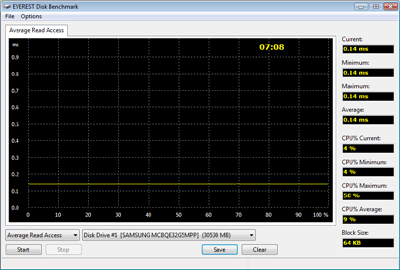
AIDA64 offers several different benchmarks for testing and optimizing your system or network. The Random Access test is one of very few if not only that will measure hard drives random access times in hundredths of milliseconds as oppose to tens of milliseconds.
Drives with only one or two tests displayed in the write test mean that they have failed the test and their Maximum and possibly their Average Scores were very high after the cache fills. This usually happens only with controllers manufactured by JMicron and Toshiba.

The read access times are the same between these two Force drives.

The write access times are as well, but this wasn't what I expected to see happen. With more interleaving on one drive and Toggle Mode flash on the other, I expected one of these drives to stand out, but as you can see, they are identical.
Benchmarks - CrystalDiskMark
CrystalDiskMark
Version and / or Patch Used: 3.0 Technical Preview
Developer Homepage: http://crystalmark.info
Product Homepage: http://crystalmark.info/software/CrystalDiskMark/index-e.html
Download here: http://crystaldew.info/category/software/crystaldiskmark
CrystalDiskMark is a disk benchmark software that allows us to benchmark 4K and 4K queue depths with accuracy.
Key Features:-
* Sequential reads/writes
* Random 4KB/512KB reads/writes
* Text copy
* Change dialog design
* internationalization (i18n)
Note: Crystal Disk Mark 3.0 Technical Preview was used for these tests since it offers the ability to measure native command queuing at 4 and 32.

Incompressible read performance was also the exact same for these two Force drives. Just hang tight though as we are starting to get somewhere.

Ah HA! Incompressible write performance, like we said - intense loads! The sequential write performance is quite a bit higher with incompressible data, movies, music and such. When you are moving a large file around it's a good chance that the data is incompressible. The difference is roughly 50MB/s with the lead going to the Force GT 240GB with the 32 chip design.
The single command 4K numbers are identical, but when the commands start to scale up so does the Force GT over the Force GS 240GB.
Benchmarks - PCMark Vantage Hard Disk Tests
PCMark Vantage - Hard Disk Tests
Version and / or Patch Used: 1.0.0
Developer Homepage: http://www.futuremark.com
Product Homepage: http://www.futuremark.com/benchmarks/pcmark-vantage/

PCMark Vantage is the first objective hardware performance benchmark for PCs running 32 and 64 bit versions of Microsoft Windows Vista. PCMark Vantage is perfectly suited for benchmarking any type of Microsoft Windows Vista PC from multimedia home entertainment systems and laptops to dedicated workstations and high-end gaming rigs. Regardless of whether the benchmarker is an artist or an IT Professional, PCMark Vantage shows the user where their system soars or falls flat, and how to get the most performance possible out of their hardware. PCMark Vantage is easy enough for even the most casual enthusiast to use yet supports in-depth, professional industry grade testing.
FutureMark has developed a good set of hard disk tests for their PCMark Vantage Suite. Windows users can count on Vantage to show them how a drive will perform in normal day to day usage scenarios. For most users these are the tests that matter since many of the old hat ways to measure performance have become ineffective to measure true Windows performance.

HDD1 - Windows Defender
HDD2 - Gaming
HDD3 - Windows Photo Gallery
HDD4 - Vista Startup
HDD5 - Windows Movie Maker
HDD6 - Windows Media Center
HDD7 - Windows Media Player
HDD8 - Application Loading
Like we said, splitting hairs, but across the board in our real-world applications tests using PCMark Vantage, we see the Force GT 240GB 32 NAND design running just a little faster.
Benchmarks - PCMark Vantage - Drives with Data Testing
For a complete breakdown on the Drives with Data Testing please read this article. You will be able to perform this test at home with the files provided in the article - full instructions are included.
- Brief Methodology
SSDs perform differently when used for a period of time and when data is already present on the drive. The purpose of the Drives with Data testing is to show how a drive performs in these 'dirty' states. SSDs also need time to recover, either with TRIM or onboard garbage collection methods.
Drives with Data Testing - 25%, 50%, 75% Full States and Dirty / Empty Test
Files needed for 60 (64GB), 120 (128GB), 240 (256GB)
60GB Fill - 15GB, 30GB, 45GB
120GB Fill - 30GB, 60GB, 90GB
240GB Fill - 60GB, 120GB, 160GB
Empty but Dirty - a test run just after the fill tests and shows if a drive needs time to recover or if performance is instantly restored.

HDD1 - Windows Defender
HDD2 - Gaming
HDD3 - Windows Photo Gallery
HDD4 - Vista Startup
HDD5 - Windows Movie Maker
HDD6 - Windows Media Center
HDD7 - Windows Media Player
HDD8 - Application Loading
Going to the next dimension with data on the drives we see the Force GT 240GB 32 NAND design also taking a very small lead over the Force GS 16 NAND 240GB drive.
Benchmarks - AS SSD
AS SSD Benchmark
Version and / or Patch Used: 1.2.3577.40358
Developer Homepage: Alex Intelligent Software
Product Homepage: Alex Intelligent Software
Download here: http://www.alex-is.de/PHP/fusion/downloads.php?cat_id=4&download_id=9
AS determines the performance of Solid State Drives (SSD). The tool contains four synthetic as well as three practice tests. The synthetic tests are to determine the sequential and random read and write performance of the SSD. These tests are carried out without the use of the operating system caches.
In all synthetic tests the test file size is 1GB. AS can also determine the access time of the SSD, the access of which the drive is determined to read through the entire capacity of the SSD (Full Stroke). The write access test is only to be met with a 1 GB big test file. At the end of the tests three values for the read and write as well as the overall performance will be issued. In addition to the calculated values which are shown in MB/s, they are also represented in IO per seconds (IOPS).
Note: AS SSD is a great benchmark for many tests, but since Crystal Disk Mark covers a broader range of 4K tests and HD Tune Pro covering sequential speeds, we will only use the Copy Benchmark from AS SSD.
- Copy Benchmark

The copy performance tests are back and forth between these two until you get into the ISO file that is already compressed data (incompressible) and in a large sequential alignment. This verifies what we saw in the CDM Write test, but makes the data a little easier to relate to.
Benchmarks - Anvil Storage Utilities
Anvil Storage Utilities
Version and / or Patch Used: BETA 11
So what is Anvil Storage Utilities? First of all, it's a storage benchmark for SSDs and HDDs where you can check and monitor your performance. The Standard Storage Benchmark performs a series of tests, you can run a full test or just the read or the write test or you can run a single test, i.e. 4K DQ16.
Anvil Storage Utilities is not officially available yet but we've been playing with the beta for several months now. The author, Anvil on several international forums has been updating the software steadily and is adding new features every couple of months.
The software can be used several different ways and to show different aspects for each drive. We've chosen to use this software to show the performance of a drive with two different data sets. The first is with compressible data and the second data set is incompressible data. Several users have requested this data in our SSD reviews.
0-Fill Compressible Data

Incompressible Data
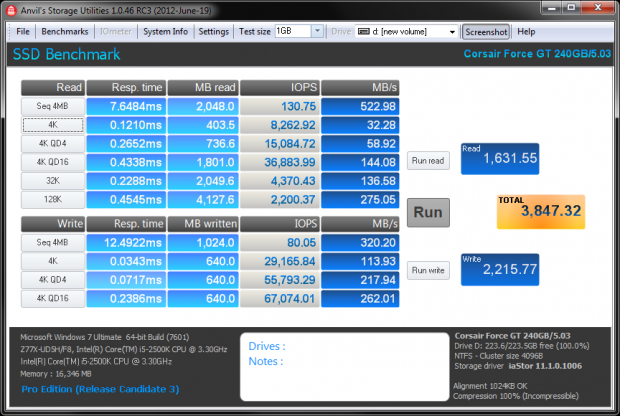
Like all SandForce SSDs there is a gap between compressible and incompressible data performance. The 32 chip design Force GT is just a small percent slower with compressible data. The incompressible score is almost 300 points faster than the Force GS, though.
4K Random Read QD32

When I reviewed the original Corsair Force GS 240GB I wasn't posting the high queue depth test numbers so I don't have a visual, but the GS scored 49,291.3 IOPS in this test. As you can see, using the same firmware and same test perimeters the Force GT 240GB with 32 NAND flash chips reads at high queue depth at around 20K more IOPS.
Most users will never get to a queue depth of 32; I would actually go as far to say that you would have to work pretty hard to get up that high, but it is what it is, advantage GT once again.
4K Random Write QD32

Both the GT and GS 240GB score nearly the same in the high queue depth write test.
Benchmarks - Passmark
Passmark Advanced Multi-User Tests
Version and / or Patch Used: 6.1
Developer Homepage: http://www.passmark.com
Test Homepage: http://www.passmark.com
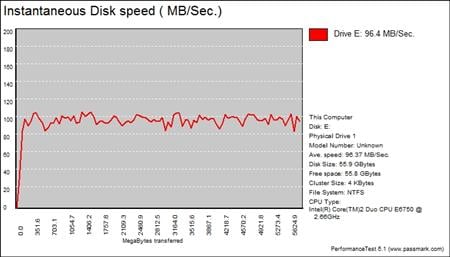
Many users complain that I/O Meter is too complicated of a benchmark to replicate results so my quest to find an alternative was started. Passmark has added several multi-user tests that measure a hard drives ability to operate in a multi-user environment.

The tests use different settings to mimic basic multi-user operations as they would play out on your server. Variances is read / write percentage as well as random / sequential reads are common in certain applications, Web Servers read nearly 100% of the time while Database Servers write a small amount of data.
The Workstation test is the only single user environment and will be similar to how you use your system at home.
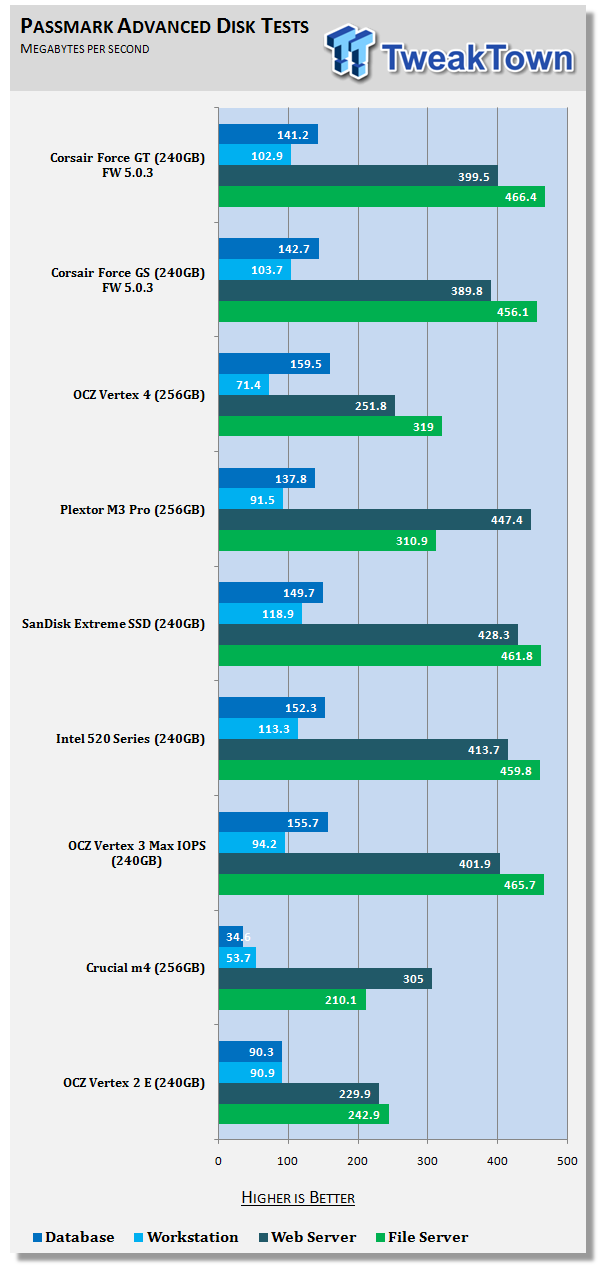
On the enterprise side these two drives are pretty much the same.
Final Thoughts

We look at a lot of SSDs around here, maybe even more than anyone else in the world. LSI SandForce isn't going to let anyone make a really bad drive... aside from asynchronous drives, but that's another story. The point is, there is a starting point and LSI SandForce has that bar set pretty high just to get in the game. We see a lot of starting point drives and they are very good. What we don't see enough of are exceptional drives. The Corsair Force GT 240GB is one of the exceptions to the rule, a drive that on paper matches other products, but in real-world delivers just a little bit more. When shopping for an SSD, as long as the money is comparable, I'd choose the faster option any day... even if it is just a little bit faster.
What we've shown today is not going to play across the entire Corsair Force GT product line when compared to all of the Force GS product line. The 240GB Force GT is a rare build with a special configuration. The Force GS 120GB should outperform the Force GT in the exact same tests where the Force GT 240GB outperforms the Force GS 240GB. Since our review of the Force GS 240GB a few weeks ago we've had a lot of emails asking us to answer the question we posted in the GS review, which one should you buy.
Today we've shown that for the 240GB capacity size the Force GT is a little faster across the board. The Force GT 240GB also has a price of just $170 after a mail in rebate, the Force GS 240GB has a $209 price without a rebate so once again, the Force GT 240GB takes another major category.
Both drives ship with the same warranty, accessories and use the same 9.5mm z-height case so there isn't an advantage either way as far as that goes. There is one metric we haven't discussed and that is power. With 32 NAND flash chips the Force GT pulls more power across the board, idle, random read, random write, sequential read and sequential write. In a notebook you are running C-State heavy so performance is actually limited artificially by your OS and notebook hardware. This saves the battery duty cycle and increases battery life. On a desktop we turn all of that off and could care less about a couple of amps here and there for storage products. In a notebook though, the Force GS 240GB is one of my leading drives right now in our new power test methods we are currently putting together to add to our storage product reviews.
The Corsair Force GT 240GB has superior performance and price when compared to the Force GS 240GB when both drives are running the same firmware. If you want to know which one to buy in this capacity size right now for desktop use, the Force GT 240GB is where to put your money.


 United
States: Find other tech and computer products like this
over at
United
States: Find other tech and computer products like this
over at  United
Kingdom: Find other tech and computer products like this
over at
United
Kingdom: Find other tech and computer products like this
over at  Australia:
Find other tech and computer products like this over at
Australia:
Find other tech and computer products like this over at  Canada:
Find other tech and computer products like this over at
Canada:
Find other tech and computer products like this over at  Deutschland:
Finde andere Technik- und Computerprodukte wie dieses auf
Deutschland:
Finde andere Technik- und Computerprodukte wie dieses auf